Physical Address
304 North Cardinal St.
Dorchester Center, MA 02124
Bacterial infections in the lung can be divided into those that are the typical causes of respiratory infections ( Streptococcus, Staphylococcus, Pseudomonas, Haemophilum, and Klebsiella ) and those that are classified as unusual or atypical causes of these infections ( Legionella, Mycoplasma, and Chlamydophila ). The causal organisms in these infections are diagnosed using a combination of clinical, pathologic, and microbiologic evidence. In this chapter, we will discuss typical and atypical groups of organisms and highlight the common anatomic pattern of injury that each one causes in the lung while outlining the distinguishing clinical and microbiologic features used to accurately diagnose and treat the offending organism.
Many organisms can cause pneumonia; however, most respiratory illness is the result of infection by five groups of organisms: Streptococcus pneumoniae, Haemophilum influenzae, Staphylococcus spp., Pseudomonas aeruginosa, and Klebsiella pneumoniae. Though the setting in which one acquires these infections is changing, in general, the first two groups are most commonly acquired in the community and referred to as forms of community-acquired pneumonia (CAP), whereas the latter three groups most often represent complications in patients within the hospital setting and are referred to as forms of hospital-acquired pneumonia (HAP). The organisms discussed in this chapter will be organized into these two categories, though it is important for the reader to realize that the shift of these organisms from causal agents in the community to causes of hospital pneumonias is ongoing.
Streptococcus Pneumoniae (Pneumococcal Pneumonia)
Streptococcus pneumoniae is also known as pneumococcus, a term coined soon after its discovery because of its association with pulmonary infections, and Diplococcus pneumoniae, because it has paired cocci in tissue and liquid culture. It is a leading cause of meningitis, otitis media, bacteremia, and pneumonia in the United States.
Pneumonia due to S. pneumoniae is the most common cause of community-acquired pneumonia. It usually develops in infants or the elderly, in the setting of overcrowded environments, or in individuals with an increased risk of aspiration such as alcoholics. In addition to lung infections, S. pneumoniae is also the most common cause of otitis media and bacterial sinusitis with abscess formation. Suppressed immune responses including damage to the mucociliary tree (smokers), defective immunoglobulin response, neutropenia, or defects in the complement cascade are also risk factors for this type of pneumonia.
S. pneumoniae can be found in the respiratory tract of normal hosts. However, when a pathogen, the symptoms are characterized by sudden onset of chills, pleuritic chest pain, high fever, and cough productive of “rust-colored” sputum. Tachycardia, tachypnea, and dyspnea are frequently seen. Laboratory values are remarkable for a leukocytosis with a shift toward immature forms and, in severe cases, leukopenia.
Also called pneumococcus ( Diplococcus pneumoniae ), S. pneumoniae causes meningitis, otitis media, bacteremia, and pneumonia.
Leading cause of community-acquired bacterial pneumonia.
Infiltrates may involve any lobe and can progress from bronchopneumonia to lobar consolidation.
Excellent prognosis with prompt treatment.
Most individuals recover in 1 to 2 days.
More common in infants, elderly, patients with immunoglobulin deficiencies, aspiration, splenectomy, sickle cell disease.
Sudden onset of chills, pleuritic chest pain, high fever, “rust-colored” sputum.
Laboratory values show leukocytosis or leukopenia.
Patchy infiltrates that progress to lobar consolidation.
Posterior and lower segments of lower lobes are most common sites.
Cavities are rare; pleural effusions may be present.
Penicillin is drug of choice, though resistance is found in 30% of isolates.
Vaccine can prevent bacteremia in patients at risk for developing complications from the pneumonia.
Chest imaging usually shows patchy infiltrates that involve more than one lung segment and may progress to complete lobar consolidation, cavity formation, and pleural effusions.
However, from one third to one half of pneumonias due to this organism may present with atypical features—that is, not confined to a single lobe—and pneumococcal pneumonia is often bilateral.
Pneumococcal pneumonia is the most common cause of lobar pneumonia that progresses from a red hepatization phase to a gray hepatization phase. The affected lobe may appear purple, and frothy fluid may exude from the surface and bronchi in the most exaggerated cases ( Figure 12-1 ). A bronchopneumonia (lobular) pattern is more commonly seen in the very young or the very old ( Figure 12-2 ). Fibrinous pleuritis and pleural effusions are present in about two thirds of the cases, and it is these pathologic features that are responsible for the pleuritic pain that is usually experienced by these patients. The consolidation is more common in the posterior and lower segments of the lobe and more commonly seen in the lower lobes. Necrosis and cavitation are rare, and empyemas occur in only about 2% of patients. Bacteremia occurs in approximately 25% to 35% of cases and is more commonly seen in the lobar pneumonia pattern of injury.

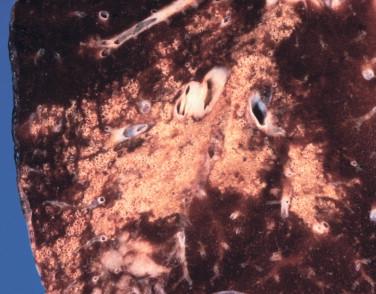
In the early stages of the disease, alveoli show congestion with increased fluid. The alveolar space contains fibrin, neutrophils, mononuclear cells, and erythrocytes, and there are distended alveolar capillaries and hyaline membranes within alveolar ducts ( Figure 12-3 ). Gram-positive organisms are abundant within neutrophils and macrophages. The fibrinous exudate present in the alveoli may also be found within the large airways. As the disease progresses, the intra-alveolar exudates will begin to organize and the pleuritis may undergo fibrosis, resulting in a firm lobe of lung encased within a fibrous capsule.
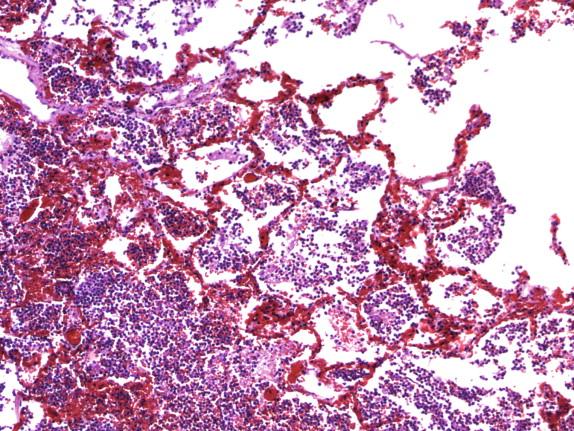
The organism is fragile and requires immediate plating for successful cultures. When cultured on blood agar, the organisms commonly grow in chains and cause an alpha hemolysis. Sputum is more sensitive than cultures in making a diagnosis, where abundant gram-positive lancet-shaped diplococci are seen within the neutrophils.
Lobar consolidation that progresses from red to gray hepatization phase.
Fibrinous pleuritis.
Pleural effusions may progress to empyemas (2% of patients).
Intra-alveolar fibrinous exudates with neutrophils and mononuclear cells.
Marked capillary congestion.
Gram-positive cocci in pairs.
Sputum is more sensitive than cultures for diagnosis.
Other non-necrotizing pneumonias such as H. influenzae and K. pneumoniae.
Viral pneumonias including influenza.
The differential diagnosis includes other predominantly non-necrotizing bacterial pneumonias due to Haemophilum influenzae and Klebsiella pneumoniae and some viral pneumonias, especially influenza.
Penicillin is considered the drug of choice for S. pneumoniae pneumonia. However, because this infection has the potential to advance rapidly, usually initial treatment is started before microbiologic confirmation and consists of additional antibiotics including cephalosporins, doxycycline, macrolides, clindamycin, and fluoroquinolones. Antibiotic resistance, an increasing problem, is found in approximately 30% of isolates. With prompt treatment, most individuals begin to recover with 1 to 2 days. Radiographic resolution is usually complete by 2 to 3 weeks. A mortality rate of 15% to 20% can be seen in the setting of bacteremia.
Pneumococcal vaccine can prevent bacteremia in individuals at high risk for developing complications from this pneumonia. These include the young and the old and individuals with chronic obstructive pulmonary disease, diabetes, cardiovascular disease, alcoholism, asplenia, renal insufficiency, and immunosuppression of various types.
HAEMOPHILUM INFLUENZAE
Haemophilum influenzae is colonizer of the upper airways in up to 50% of the population and may colonize the lower respiratory tract in patients with either chronic bronchitis or bronchiectasis. It causes pneumonia either through hematogenous spread or by aspiration into chronically inflamed lungs. Six serotypes (A-F) are defined based on their capsular antigens. Both children and adults are susceptible to these pulmonary infections, usually by type B, an encapsulated strain. These organisms are also responsible for a spectrum of other infections including meningitis, epiglottitis, otitis, and arthritis.
H. influenzae pneumonia is found predominantly in children. In adults, it is found in the setting of underlying chronic lung disease such as chronic bronchitis, bronchiectasis, or cystic fibrosis, with HIV infection, or in alcoholics. Epiglottitis is a common manifestation of this infection in children. The pneumonia is usually preceded by a viral or mycoplasma infection that disrupts the airway mucosa, predisposing it to infections by these colonizing organisms. Symptoms for H. influenzae pneumonia are fever, a cough productive of purulent sputum, and myalgias. Most commonly found as a community-acquired pneumonia, its role as a HAP is increasing, especially in younger patients.
Colonizer of upper airways in 50% of the population.
Cause of CAP in lower airways through aspiration and hematogenous spread.
Six serotypes (A-F).
Most common in children and adults with chronic lung disease such as chronic bronchitis, bronchiectasis, or cystic fibrosis.
Most common as CAP though increasing incidence as HAP.
No significant morbidity or mortality with prompt treatment with antimicrobials.
Mortality may be higher with bacteremia.
More common in children.
Alcoholics and HIV(+) patients are higher risk.
Fever.
Cough with productive purulent sputum.
Myalgias.
Localized lobar or segmental consolidation.
Diffuse miliary pattern with hematogenous spread.
H. influenzae pneumonia is usually localized with a lobar or segmental consolidation. In patients with hematogenous spread, a diffuse miliary pattern may be present. Cavitation, pleural effusion, or empyemas can be seen but are not common.
The pneumonia starts out as a lobular pneumonia that undergoes consolidation ( Figure 12-4 ). This progresses to a necrotizing pneumonia with a lobar pattern. Cavitation or pneumatoceles, when present, usually arise out of the lobar pattern and are more common in children.
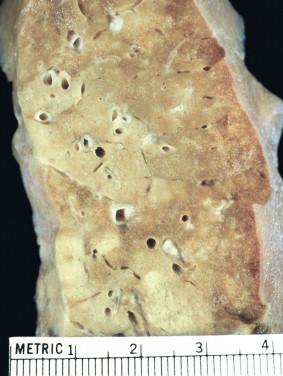
The infiltrate is rich in neutrophils with fibroblastic proliferation and organization in the peripheral areas ( Figure 12-5 ). A pleural effusion may be present with a fibrinous pleuritis.
Lobar or segmental consolidation.
Fibrinous pleuritis.
Cavitation and empyemas are unusual but may develop in children.
Bronchocentric, neutrophilic-rich alveolitis.
Gram-negative coccobacillus.
Most pneumonias caused by nonencapsulated, nontypable strain.
Difficult to culture; organisms are seen in gram-stained sputum.
Streptococcal pneumonia.
Staphylococcal pneumonia.
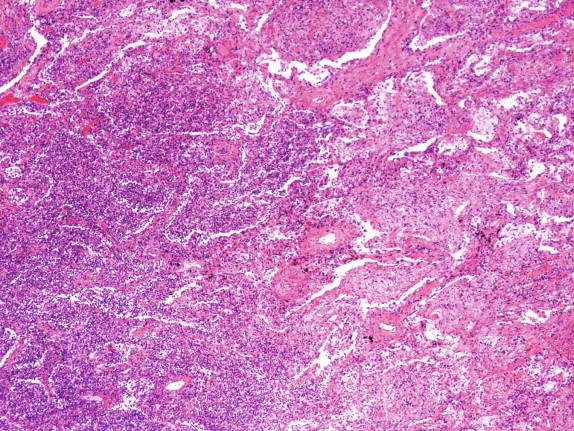
H. influenzae is a gram-negative coccobacillus that is somewhat difficult to culture and, because it is a frequent colonizer of the upper respiratory tract, positive cultures may be difficult to interpret in respiratory specimens. Organisms can be seen in gram-stained sputum, but they are relatively small and can be lost in the background cellular debris and proteinaceous exudates of the tissue. Most pneumonias are caused by the nonencapsulated, nontypable strain, with encapsulated type b the second most common strain isolated, mostly in children. Blood cultures are positive in 10% to 15% of the patients with H. influenzae pneumonia.
Streptococcal pneumonia or staphylococcal pneumonia and pneumonias caused by K. pneumoniae may mimic this predominantly non-necrotizing pneumonia.
Patients usually survive this pneumonia when treated promptly with antimicrobials. Due to increasing bacterial resistance, the treatment of choice is third-generation cephalosporin antibiotics. However, amoxicillin/clavulanate (Augmentin) with trimethoprim/sulfamethoxazole (Bactrim) is effective in beta-lactamase positive strains. Mortality may be higher with bacteremia. A vaccine to H. influenzae type b (HIB vaccine) has been shown to be effective in preventing infections in children.
STAPHYLOCOCCUS SPECIES
Pneumonia due to Staphylococcus species accounts for approximately 10% of all of pneumonias. S. aureus, the most common organism isolated, is a gram-positive coccus that usually grows in clusters. S. epidermidis and S. saprophyticus may cause pneumonia but are not common pathogens in the lungs. Staphylococcus sp. give off multiple toxins that may cause both localized tissue injury in the form of abscesses and systemic tissue injury as is seen in toxic shock syndrome.
Pneumonia due to Staphylococcus species usually develops from either aspiration of organisms from upper airway infections or oral secretions or from hematogenous seeding of the lung during bacteremia. It is twice as common as a hospital-acquired infection than as a community-acquired one. Staphylococci colonize the anterior nasal cavity or the skin in 30% to 50% of normal adults and in higher rates in diabetic patients, patients on hemodialysis, or intravenous drug abusers. Staphylococcal pneumonia is commonly a complication in patients with influenza, cystic fibrosis, in the immunocompromised, and in the very young and the very old. The clinical course in these patients is usually slow to progress but can quickly develop into high fevers, chills, cough productive of purulent bloody sputum, dyspnea, and, occasionally, pleuritic chest pain.
More common as HAP.
Toxins cause localized tissue injury in form of abscesses or systemic disease such as toxic shock syndrome.
Ten percent of all pneumonias.
Twenty-five percent to 30% mortality and may be as high as 80% with complications such as bacteremia, cavitation, or empyema.
More common in the very young and the very old.
Usually the result of hematogenous spread from other sources.
Twice as common as a HAP than as a CAP.
Common in patients with influenza, cystic fibrosis patients, immunocompromised patients.
Patchy, bilateral, lower lobe infiltrates.
May progress to complete consolidation.
Pleural effusions in over half of patients and cavitation, abscess formation, and empyema may follow.
Immediate treatment with penicillins or cephalosporins.
Methicillin resistance is growing problem, which requires vancomycin.
Staphylococcal pneumonia usually manifests as patchy, bilateral, lower-lobe infiltrates that may progress to complete consolidation. Early infection is based around the bronchioles as an early necrotizing bronchopneumonia and a “tree and bud” appearance. Large abscess cavities may occur in over half of patients who have pleural effusions, and the majority of these will progress to empyema ( Figure 12-6 ).
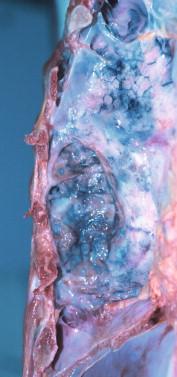
During the acute infection, the lungs are congested with a purple-red color and a minimal pleural reaction. Pleural effusions are common and usually of a serosanguineous quality. Airways and cut surfaces may contain bloody fluid and a thick, exudative bronchitis with pseudomembrane formation. Progression of the disease usually results in a necrotizing, peribronchiolar pattern that develops into multiple, thin-walled cavities (pneumatoceles) from 1 to 5 cm in diameter with thick yellow-green pus ( Figure 12-7 ). These are especially common in children.
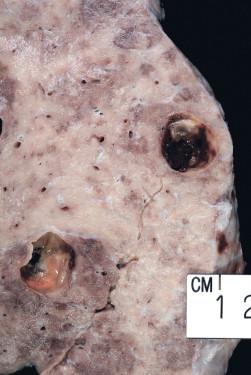
Staphylococcal pneumonia is predominantly a bronchopneumonia that develops around the centrilobular bronchiole that may arise out of an acute, necrotizing tracheobronchitis and spread distally to involve the alveoli. This acute, exudative infiltrate usually expands to fill large areas of the surrounding lung and commonly develops into a necrotizing pneumonia with cavitation and abscess formation ( Figure 12-8 ). Within the phagocytes of the infiltrates, gram-positive cocci are abundant, usually in grapelike clusters. Though pleuritis is uncommon, extension of these cavities to the pleural surface and empyema formation are common. Hematogenous staphylococcal pneumonia usually develops in the lower lobes and is subpleurally centered on a necrotic artery. Septic infarction can occur that may lead to empyema and pneumothorax.
Red/purple lungs with bloody fluid and exudative bronchitis.
Disease progression results in thin-walled cavities with thick yellow-green pus.
Extension of these cavities to pleural surface and empyema formation is common.
Become a Clinical Tree membership for Full access and enjoy Unlimited articles
If you are a member. Log in here